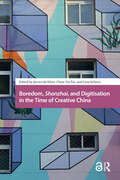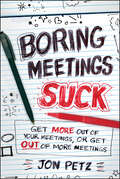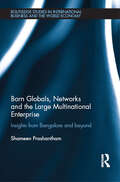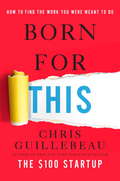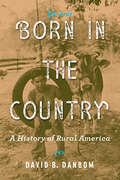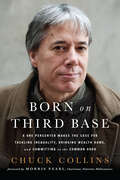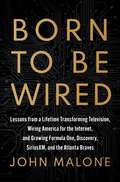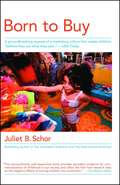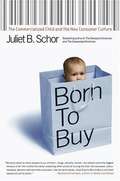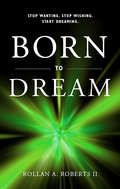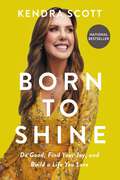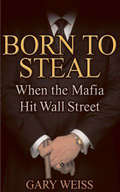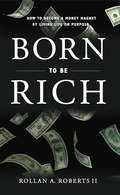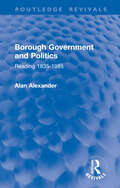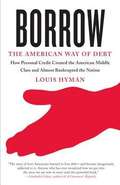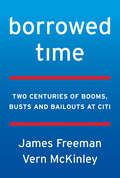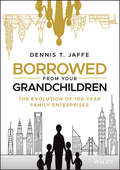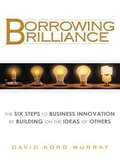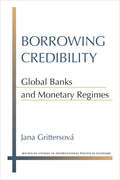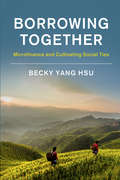- Table View
- List View
Boredom, Shanzhai, and Digitisation in the Time of Creative China (Asian Visual Cultures)
by Jeroen De Kloet Chow Yiu Fai Lena ScheenWith its emergence as a global power, China aspires to transform from made in China to created in China. Mobilised as a crucial source for solid growth and soft power, creativity has become part of the new China Dream. Boredom, Shanzhai, and Digitisation in the Time of Creative China engages with the imperative of creativity by aligning it to three interrelated phenomena: boredom, shanzhai, and digitisation. How does creativity help mitigate boredom? Does boredom incubate creativity? How do shanzhai practices and the omnipresence of fake goods challenge notions of the original and the authentic? Which spaces for expressions and contestations has China's fast-developing digital world of Weixin, Taobao, Youku, and Internet Plus Policy opened up? Are new technologies serving old interests? Essays, dialogues, audio-visual documents, and field notes, from thinkers, researchers, practitioners, and policy-makers, examine what is going on in China now, ultimately to tease out its implication to our understanding of creativity.|Introduction I. Jeroen de Kloet, Yiu Fai Chow, and Lena Scheen We Must Create II. Eitan Wilf 'Creative China' and Its Potential to Problematise Western-modern-romantic Ideologies of Creativity Section 1: Boredom Essays 1.1: Anneke Coppoolse Create No More! Clutter and Boredom, a Hong Kong Prospective 1.2: Wen Cuiyan Combating the Boredom of Traditional Performing Art? The Case of Muk-jyu-go Interlocuting 1.3: Esther Peeren You Must (Not) Be Bored! Boredom and Creativity in Global Capitalism 1.4: Christoph Lindner Boredom and Creativity in the Era of Accelerated Living Notes from the field 1.5: Laura Vermeeren Evaporating Ennui - Water Calligraphy in Beijing 1.6: Li Hao Male Cinderella on the Small Screen in Mainland China In Dialogue 1.7: Yin Shan Lo, Kingsley Ng, and Kung Chi Shing 'Performativity' in the Age of Banality Section 2: Shanzhai Essays 2.1: Anthony Fung and Yiyi Yin New Productive Culture: Shanzhai or Second Degree of Creation? 2.2: Louis Ho Creative 'Shanzhai Labour'? - Leung Mei-ping's 'Made in Hong Kong/Shenzhen' 2.3: Xiao Yuefan Maoism and Disruptive Creativity: Shanzhai - an Alternative Perspective Interlocuting 2.4: Lena Scheen 'Isn't that funny?': The Unsettling Effect of Shanzhai Products 2.5: Stefan Landsberger Shanzhai = Creativity, Creativity = Shanzhai Notes from the field 2.6: Feng Fan Bringing the Chinese Dream to the U.S.A.: A Curatorial Practice in Art Education 2.7: Arjen Nauta 'Banal Creativity': What Does It Mean to be Creative for Hunan TV Practitioners? In Dialogue 2.8: Yin Shan Lo, Dai Dai, and Deng Chunru Two Side of SZ (Shanzhai & Shenzhen) Section 3: Digitisation Essays 3.1: Michael Keane Creativity, Affordances, and Chinese Traditional Culture Interlocuting 3.2: Chen Siyu Digital Payment, Vernacular Creativity, and Governmentality 3.3: Zeng Guohua Shopping 'Natural' and 'Local' Food as Everyday Resistance: Digitisation, Platformisation, and Online Retail of Rural Products Notes from the field 3.4: Liwen Deng Participatory Art On-off a Digital Platform - a Mobius Strip: On Cyber Nails in Curated Nails 3.5: Rowan Perry On-going Digitisation and Independence Chinese Documentary: A Field Report from Beijing 2015-2016 In Dialogue 3.6: Yin Shan Lo, Janet Fong, and Isaac Leung Digitisation with (in/out) Borders Biography of Contributors Endnotes Index
Boring Meetings Suck
by Jon PetzThe guide that proves your meetings don't have to suck! There's a big dull elephant in the boardroom: this meeting! Most of the millions of meetings held in the world today are a monumental waste of time and talent. Worse still, most of the so-called solutions and books for boring meetings are twice as boring. Boring Meetings Suck provides tips and tactics to deliver "Get-In, Get-It-Done, or Get-Out" style meetings, while also tackling what most prefer to avoid; that you don't have to BE in charge of a meeting to TAKE charge of a meeting. This entertaining and take-no-prisoners guide is full of easily deployed SRDs?Suckification Reduction Devices?that will help you make your next meeting both efficient and effective. Empowers attendees to politely speak up and get a meeting back on track, or graciously get out, without being fired Shows how hosts can capitalize on technology, learning to crowd-source problems and increase participation Defines surefire methods to get meetings to start and end on time and not have the speaker read the slides STOPS over-invitation syndrome The author has appeared before many major corporate clients, and was named a "Top Business Professional Under 40" by American City Business Journals Your meetings do not have to bore, nor must they suck. Instead, get the winning techniques in Boring Meetings Suck, and make your meetings awesome in their engagement and productivity, or stop having them!
Boris Berezovsky, Vladimir Putin and the Russian Oligarchs
by Geoffrey G. Jones Kate Lazaroff-Puck Rachael ComunaleThis case examines the career of the Russian business oligarch Boris Berezovsky. Berezovsky was one of a small group of business tycoons that became fabulously rich after the collapse of the Soviet Union in 1991, as the new Russian government, advised by prominent Harvard economists, privatized state assets. The case provides an opportunity to explore how this happened, and what its impact was both at the time and for the subsequent development of capitalism in Russia. Berevosky's business empire suffered a major reversal after the appointment of Russian President of Vladimir Putin in 2000. Berevosky's opposition to Putin's plans to restore the authority of the Russian state led to his exile in Britain, where he reinvented himself as an opponent of authoritarianism.
Born Globals, Networks, and the Large Multinational Enterprise: Insights from Bangalore and Beyond (Routledge Studies in International Business and the World Economy)
by Shameen PrashanthamFocusing on international entrepreneurship, this research book explores the accelerated internationalization of young firms. Known variously as international new ventures (INVs) or "born globals," such firms have come to be viewed as legitimate actors on the global stage alongside large multinational enterprises (MNEs). However, the current approach taken by scholars – studying large MNEs and born globals separately – is questionable. This book explores the crucial MNE/INV interface – a fascinating, yet under-researched relationship in international entrepreneurship. Drawing upon a decade of case-based research, the author argues that the MNE influence on born globals must be considered more carefully and suggests how new ventures can leverage MNE networks in the pursuit of their rapid internationalization. Furthermore, it demonstrates that, as firms enhance their levels of innovation, new pathways emerge via multinational corporation networks, a phenomenon vividly demonstrated in the emerging economy context of the Bangalore software industry. This innovative research text will be of interest to academics, researchers, and advanced students with an interest in international entrepreneurship and business, strategy, innovation, and new ventures.
Born for This: How to Find the Work You Were Meant to Do
by Chris GuillebeauHave you ever met someone with the perfect job? To the outside observer, it seems like they've won the career lottery—that by some stroke of luck or circumstance they've found the one thing they love so much that it doesn't even feel like work—and they're getting paid well to do it. In reality, their good fortune has nothing to do with chance. There&’s a method for finding your perfect job, and Chris Guillebeau, the bestselling author of The $100 Startup, has created a practical guide for how to do it—whether within a traditional company or business, or by striking out on your own. Finding the work you were &“born to do&” isn&’t just about discovering your passion. Doing what brings you joy is great, but if you aren&’t earning a living, it&’s a hobby, not a career. And those who jump out of bed excited to go to work every morning don&’t just have jobs that turn their passions into paychecks. They have jobs where they also can lose themselves for hours in the flow of meaningful work. This intersection of joy, money, and flow is what Guillebeau will help you find in this book. Through inspiring stories of those who have successfully landed their dream career, as well as actionable tools, exercises, and thought experiments, he&’ll guide you through today&’s vast menu of career options to discover the work perfectly suited to your unique interests, skills, and experiences.You&’ll learn how to:• Hack the job of your dreams within a traditional organization by making it work for you• Find not only your ideal work but also your ideal working conditions• Create plans that will allow you to take smarter career risks and &“beat the house&” every time• Start a profitable &“side hustle&” and earn extra cash on top of your primary stream of income• Escape the prison of working for someone else and build a mini-empire as an entrepreneur• Become a rock star at any creative endeavor by creating a loyal base of fans and followersWhichever path you choose, this book will show you how to find that one job or career that feels so right, it&’s like you were born to do it.
Born in the Country: A History of Rural America (Revisiting Rural America)
by David B. DanbomThe definitive history of life in rural America.Throughout most of its history, America has been a rural nation, largely made up of farmers. David B. Danbom's Born in the Country was the first—and still is the only—general history of rural America. Ranging from pre-Columbian times to the enormous changes of the twentieth century, the book masterfully integrates agricultural, technological, and economic themes with new questions about the American experience.Danbom employs the stories of particular farm families to illustrate the experiences of rural people. This substantially revised and updated third edition • expands and deepens its coverage of the late twentieth and early twenty-first centuries• focuses on the changes in agriculture and rural life in the progressive and New Deal eras as well as the massive shifts that have taken place since 1945• adds new information about African American and Native American agricultural experiences• discusses the decline of agriculture as a productive enterprise and its impact on farm families and communities• explores rural culture, gender issues, agriculture, and the environment• traces the relationship among farmers, agribusiness, and consumersIn a new and provocative concluding chapter, Danbom reflects on increasing consumer disenchantment with and resistance to modern agriculture as well as the transformation of rural America into a place where farmers are a shrinking minority. Ultimately, he asks whether a distinctive style of rural life exists any longer.
Born on Third Base: A One Percenter Makes the Case for Tackling Inequality, Bringing Wealth Home, and Committing to the Common Good
by Chuck Collins&“A call to action for America's wealthy and a warning shot across the bows of their yachts if they fail to act, Born on Third Base offers a clear and compelling case for why the privileged and powerful must act to reverse widening inequality of income, wealth, and political power in America.&”—Robert B. Reich, former US Secretary of Labor; author of Saving CapitalismAn essential piece of reading for anyone concerned by the increasing wealth inequality–made worse by the global pandemic and political partisanshipThe growing wealth inequality continues to dominate headlines. The divide between the haves and have nots in America is increasingly political and tensions are rising. On one side, the wealthy wield power and advantage, keeping the system operating in their favor―all while retreating into enclaves that separate them further and further from the poor and working class. On the other side, those who find it increasingly difficult to keep up or get ahead are desperate and frustrated ―waging a rhetorical war against the rich and letting anger and resentment keep us from seeing new potential solutions.But can we suspend both class wars long enough to consider a new way forward? Is it really good for anyone that most of society&’s wealth is pooling at the very top of the wealth ladder? Does anyone, including the one percent, really want to live in a society plagued by economicapartheid?It is time to think differently, says longtime inequality expert and activist Chuck Collins. Born into the one percent, Collins gave away his inheritance at 26 and spent the next three decades mobilizing against inequality. He uses his perspective from both sides of the divide to deliver anew narrative.Collins calls for a ceasefire and invites the wealthy to come back home, investing themselves and their wealth in struggling communities. And he asks the non-wealthy to build alliances with the one percent and others at the top of the wealth ladder.Stories told along the way explore the roots of advantage, show how taxpayers subsidize the wealthy, and reveal how charity, used incorrectly, can actually reinforce extreme inequality. Readers meet pioneers who are crossing the divide to work together in new ways, including residents in the author&’s own Boston-area neighborhood who have launched some of the most interesting community transition efforts in the nation.In the end, Collins&’s national and local solutions not only challenge inequality but also respond to climate change and offer an unexpected, fresh take on one of our most intransigent problems.
Born to Be Wired: Lessons from a Lifetime Transforming Television, Wiring America for the Internet, and Growing Formula One, Discovery, Sirius XM, and the Atlanta Braves
by John MaloneIf you&’ve ever streamed a show on HBO Max, seen a Formula One race, hummed a tune on SiriusXM, bought concert tickets via Ticketmaster, or watched an Atlanta Braves game, you&’ve crossed paths with John Malone. You just didn&’t know it.John Malone remains a stranger to most people, though millions have been touched by the technologies and content he made possible. In Born to Be Wired, this legendary &“cable cowboy&” shares stories from behind the scenes of the most transformative deals in media, entertainment, and technology. He recounts the extraordinary saga of how America was wired—how a single copper strand evolved from a rural TV-antenna service into a high-speed backbone powering the internet and clearing the path for Amazon, Facebook, and Google. Malone offers an insider&’s account of launching television&’s first cable networks—including Discovery, TBS, QVC, and BET—and the strategy behind era-defining mergers, from Warner Bros. Discovery to Live Nation Entertainment. His Liberty Media ventures, including Formula One, have delivered long-term returns often compared to Berkshire Hathaway. More than a business story, this is a personal reflection—from a quiet kid with a mechanic&’s curiosity to a media visionary confronting the costs and consequences of disruption in an industry he helped reshape. Trained at the storied Bell Labs and gifted with a mathematical mind, Malone saw patterns in complexity. Where others saw chaos, he saw systems—and reconfigured companies with the precision of an engineer, unlocking value no one else could see. Sweeping, revealing, and deeply human, Born to Be Wired offers a rare glimpse into the logic—and the life—behind the screen.
Born to Buy
by Juliet B. SchorAds aimed at kids are virtually everywhere -- in classrooms and textbooks, on the Internet, even at slumber parties and the playground. Product placement and other innovations have introduced more subtle advertising to movies and television. Companies are enlisting children as guerrilla marketers, targeting their friends and families. Even trusted social institutions such as the Girl Scouts are teaming up with marketers. Drawing on her own survey research and unprecedented access to the advertising industry, New York Times bestselling author and leading cultural and economic authority Juliet Schor examines how a marketing effort of vast size, scope, and effectiveness has created "commercialized children."Schor, author of The Overworked American and The Overspent American, looks at the broad implications of this strategy. Sophisticated advertising strategies convince kids that products are necessary to their social survival. Ads affect not just what they want to buy, but who they think they are and how they feel about themselves. Based on long-term analysis, Schor reverses the conventional notion of causality: it's not just that problem kids become overly involved in the values of consumerism; it's that kids who are overly involved in the values of consumerism become problem kids. In this revelatory and crucial book, Schor also provides guidelines for parents and teachers. What is at stake is the emotional and social well-being of our children.Like Barbara Ehrenreich's Nickel and Dimed, Mary Pipher's Reviving Ophelia, and Malcolm Gladwell's The Tipping Point, Born to Buy is a major contribution to our understanding of a contemporary trend and its effects on the culture.
Born to Buy: The Commercialized Child and the New Consumer Culture
by Juliet B. SchorSophisticated advertising strategies convince kids that products are necessary to their social survival. Schor examines how a marketing effort of vast size, scope, and effectiveness has created "commercialized children."
Born to Dream: Stop Wanting. Stop Wishing. Start Dreaming.
by Dr Rollan Roberts IIWhat would you be or do if you knew you could not fail? How would you live if time and money were no object? What are you so passionate about that sleep escapes you? Dr. Rollan Roberts II dynamically conveys what dreams are, what they are not, and how to achieve yours in Born to Dream. In this powerful, hard-hitting read, Dr. Roberts helps you to define your dream, achieve it, and keep it alive. Learn why people give up on their dreams and the attributes of successful dreamers. Born to Dream will bring clarity to your life's purpose and the dreams within you like no other book you've read. Born to Dream will inspire you to pursue your dreams with everything you are, have, and hope to be. This thrilling book featuring business owner Sandy Sansing, Jeff Levitan, and Olympic Gold Medalist Shannon Miller is for champions - you were Born to Dream. You will discover: -10 questions you can ask to define your dreams- 7 step play-by-play for achieving your dreams - 10 ways to keep your dream alive -27 reasons people quit pursuing their dreams - 5 attributes of a champion. Olympic Gold Medalist Shannon Miller had this to say about the book: 'Dreams are a form of goal setting. Without our dreams, we have no reason to move forward. Born to Dream motivates its readers to dream big and follow through to reach success.'
Born to Shine: Do Good, Find Your Joy, and Build a Life You Love
by Kendra ScottINSTANT NATIONAL BESTSELLERThis authentic and dynamic memoir from the CEO of Kendra Scott Jewelry delivers inspiration, leadership lessons, and spellbinding storytelling. For twenty years, Kendra Scott built her eponymous jewelry company from a hobby and an idea into a company worth more than a billion dollars, creating beautiful and affordable pieces with signature-cut natural gemstones packaged in a sunny yellow box. By any measure, she&’s the woman who has it all: a self-made billionaire, a generous philanthropist, and a mother of three with a squad of strong female friendships. Sounds pretty perfect, right? But perfection is a myth that doesn&’t serve any of us. A myth that encourages us to assume that we know what other people are going through, to judge each other on appearances and reputations, to present the best versions of ourselves and pretend like we&’ve got it all together even when everything is falling apart. Perfection isn&’t just a lie, it&’s exhausting, and Kendra is tired of it. In this vulnerable, wise, and laugh-out-loud book, Kendra takes us on a journey of personal stories and hard-earned life lessons, from her humble beginnings as an awkward, bullied young girl in small-town Wisconsin to launching a business in her spare bedroom with $500. With every pitfall, misstep, and failure, Kendra builds a life—and a career—rooted in joy, purpose, and doing good, a life she wants for every reader. With heart and humor, Kendra reminds us that not all that glitters is gold, and that there is no level of success that can insulate you from what it means to be a human being: that life is as messy as it is magical, that bad things happen to good people for no good reason, and that a good life does not mean a perfect one.
Born to Shop London: The Ultimate Guide for People Who Love to Shop
by Suzy GershmanFor over twenty years, Suzy Gershman has been leading savvy shoppers to the world's best finds. Now Born to Shop London is easier to use and packed with more up-to-date listings than ever before.
Born to Steal: When the Mafia Hit Wall Street
by Gary WeissLouis Pasciuto joined a fraudulent Mafia-connected brokerage firm in 1992, slowly falling deeper and deeper into complications with high-spending lifestyle and a host of dangerous characters seeking a piece of the Wall Street action, until finally he found himself cooperating with the FBI in investigating Mafia operations in the high finance world of New York. An investigative reporter for </BusinessWeek/> that made a name from his exposes of Mafia connections to Wall Street, Weiss sympathetically narrates Pasciuto's story for a general audience. Annotation ©2004 Book News, Inc., Portland, OR (booknews.com)
Born to be Rich: How to Become a Money Magnet by Living Life on Purpose
by Dr Rollan Roberts IIDr. Rollan Roberts II dynamically describes the recipe for making the most amount of money possible and reaching your maximum level of success in the shortest period of time in Born to be Rich. Born to be Rich teaches its readers how to think about wealth, riches, and success and exactly who they must become, or continue being, in order to attract financial riches into their life. This book is excellent for entrepreneurs and business owners on building and growing a successful enterprise. People can learn how to be rich just as they can learn a profession, and their education begins with Born to be Rich. Dr. Roberts shares his story of how he grew up in the beautiful mountains of West Virginia. Although he was surrounded with mental and financial poverty, he decided early on that his reality did not equal his destiny. With an unwavering determination and commitment to excellence, he graduated college with his Bachelor's degree in 5 semesters while working full time jobs to pay his own way! After finishing up his first year of college and starting with nothing at 18, he became a millionaire shortly after graduating college at the age of 21. After losing everything shortly thereafter, he fought back to enjoy years of success in corporate America and has started several successful businesses. He is an internationally renowned, best-selling author, speaker, and TV personality. He has founded and/or led several nutraceutical, biotech, direct sales and technology organizations that experienced significant exponential global growth. He is a recognized industry expert in the biotech, nutraceutical and direct sales industry. He holds a Doctorate degree in International Business and Entrepreneurship, holds two patents (the 90 Day Race Formula and Automated Call and SMS Greetings), was a state Senate candidate in 2012, and continues to bring hope to millions of people around the world through various products, services, speeches, and interviews.
Borough Government and Politics: Reading 1835-1985 (Routledge Revivals)
by Alan AlexanderOriginally published in 1985, this book was a study of one example of an all-purpose, unitary, borough council in the UK. It covers the years since the democratization of the borough councils in 1835, through the attainment of county borough status in 1888, the major expansion in local government services in the first six decades of the 20th Century, and the decline, after reorganization, of both the boroughs in particular and local government in general. The book assesses the impact of the Borough Council on the town of Reading and its inhabitants, dealing with the politics of territorial expansion, the attempts to make a coherent education and the process by which local politics became dominated by political partisanship. The book’s examination, largely based on original sources, of government and politics in one English town, is of broader relevance to fields such as political history and the development of the party system. It will be of interest to local and urban historians and students of politics and public administration.
Borrow
by Louis HymanIn this lively history of consumer debt in America, economic historian Louis Hyman demonstrates that today's problems are not as new as we think. Borrow examines how the rise of consumer borrowing--virtually unknown before the twentieth century--has altered our culture and economy. Starting in the years before the Great Depression, increased access to money raised living standards but also introduced unforeseen risks. As lending grew more and more profitable, it displaced funds available for business borrowing, setting our economy on an unsustainable course. Told through the vivid stories of individuals and institutions affected by these changes, Borrow charts the collision of commerce and culture in twentieth-century America, giving an historical perspective on what is new--and what is not--in today's economic turmoil.
Borrowed Time: Two Centuries of Booms, Busts, and Bailouts at Citi
by James Freeman Vern McKinleyThe disturbing, untold story of one of the largest financial institutions in the world, Citigroup—one of the " too big to fail" banks—from its founding in 1812 to its role in the 2008 financial crisis, and the many disasters in between.During the 2008 financial crisis, Citi was presented as the victim of events beyond its control—the larger financial panic, unforeseen economic disruptions, and a perfect storm of credit expansion, private greed, and public incompetence. To save the economy and keep the bank afloat, the government provided huge infusions of cash through multiple bailouts that frustrated and angered the American public.But, as financial experts James Freeman and Vern McKinley reveal, the 2008 crisis was just one of many disasters Citi has experienced since its founding more than two hundred years ago. In Borrowed Time, they reveal Citi’s history of instability and government support. It’s not a story that either Citi or Washington wants told.From its founding in 1812 and through much of its history the bank has been tied to the federal government—a relationship that has benefited both. Many of its initial stockholders had owned stock in the Bank of the United States, and its first president, Samuel Osgood, had been a member of the Continental Congress and America’s first Postmaster General. From its earliest years, Citi took massive risks that led to crisis. But thanks to private investors, including John Jacob Astor, they survived throughout the nineteenth century.In the twentieth century, Senator Carter Glass blamed Citi CEO "Sunshine Charlie" Mitchell for the 1929 stock market crash, and the bank was actually in violation of the senator’s signature achievement, the Glass-Steagall law, in the late 1990s until then U.S. Treasury Secretary Robert Rubin engineered the law’s repeal. Rubin later became the chairman of the executive committee of Citigroup, helping to oversee the bank as it ramped up its increasing mortgage risks before the 2008 crash.The scale of the financial panic of 2008 was not, as the media and experts claim, unprecedented. As Borrowed Time shows, disasters have been relatively frequent during the century of government-protected banking—especially at Citi.
Borrowed from Your Grandchildren: The Evolution of 100-Year Family Enterprises
by Dennis T. JaffeFamilies share how they have maintained and grown their wealth from generation to generation. While creating wealth is a wonderful achievement, business families are also concerned with how their wealth is used to support their values, the lives of their children and the well-being of the community. Over several generations, families who are successful in growing their wealth have been able to reinvent themselves and their business in the face of significant environmental transformations and internal differences cause by family dynamics. Borrowed from my Grandchildren is a fascinating look at how large, long-lasting business families succeed across generations. Author Dennis T. Jaffe, one of the leading architects of the field of family enterprise consulting, has interviewed members of successful, well known, 100-year family enterprises from 20 countries, who serve as role models for those wishing to see their wealth positively impact their children, employees, and communities. Half continue to own their legacy business and others have gone on to become family offices with a portfolio of shared assets, but all these families have sustained their values and identity as a family over more than three generations. Offering the collected wisdom of nearly 100 global business families, this insightful book shares the real-life stories of partners in business and wealth management over three of more generations. Families that generate rather than reduce their wealth across generations, known as Generative Families, focus on engaging across generations and develop collaborative governance for both family and business to ensure responsible stewardship from one generation to the next. This unique resource: Presents real-life stories of families sustaining wealth over generations Explores both the successes and failures of retaining family wealth Includes rare private insights from members of prominent wealthy families Examines the nature of global family enterprises and their evolution over generations Discusses the financial, human, and social dimensions of wealth Borrowed from my Grandchildren: The Evolution of Stewardship in 100-Year Families is an essential read for family members, non-family executives, family offices, estate planning lawyers, family business consultants, trust officers, philanthropic and foundation advisors, financial advisors, financial planners, CPAs, and other finance professionals.
Borrowing Brilliance
by Murray David KordAs a former aerospace scientist, Fortune 500 executive, chief innovation officer of two major companies, inventor and software entrepreneur, David Murray has made a living by coming up with new and innovative ideas. In Borrowing Brilliance he explains the origins and evolution of a business idea by showing you how new ideas are merely the combination of existing ideas. Since brilliance is actually borrowed, its easily within reach. Its really a matter of knowing where to borrow the materials and how to put them together that determines creative ability. Murray presents a simple Six-Step process that anyone can use to build business innovation: Step One: DefiningDefine the problem that youre trying to solve. Step Two: BorrowingBorrow ideas from places with a similar problem. Step Three: CombiningConnect and combine these borrowed ideas. Step Four: IncubatingAllow the combinations to incubate into a solution. Step Five: JudgingIdentify the strength and weakness of the solution. Step Six: EnhancingEliminate the weak points while enhancing the strong ones. Each chapter features real-life examples of brilliant borrowers, including profiles of Larry Page and Sergey Brin (the Google Guys), Bill Gates, George Lucas, Steve Jobs, Albert Einstein, and other creative thinkers. Murray used these methods to re-create his own career and he shows how you can harness them to find your own creative solutions. First you copy, then you create. And the further youre your own company you look, the more creative the solution.
Borrowing Credibility: Global Banks and Monetary Regimes
by Jana GrittersovaNations with credible monetary regimes borrow at lower interest rates in international markets and are less likely to suffer speculative attacks and currency crises. While scholars typically attribute credibility to domestic institutions or international agreements, Jana Grittersová argues that when reputable multinational banks headquartered in Western Europe or North America open branches and subsidiaries within a nation, they enhance that nation’s monetary credibility. These banks enhance credibility by promoting financial transparency in the local system, improving the quality of banking regulation and supervision, and by serving as private lenders of last resort. Reputable multinational banks provide an enforcement mechanism for publicized economic policies, signaling to international financial markets that the host government is committed to low inflation and stable currency. Grittersová examines actual changes in government behavior of nations trying to gain legitimacy in international financial markets, and the ways in which perceptions of these nations change in relation to multinational banks. In addition to quantitative analysis of over 80 emerging-market countries, she offers extensive case studies of credibility building in the transition countries of Eastern Europe, Argentina in 2001, and the global financial crisis of 2008. Grittersová illuminates the complex interactions between multinational banks and national policymaking that characterize the process of financial globalization to reveal the importance of market confidence in a world of mobile capital.
Borrowing Together (Studies of the Weatherhead East Asian Institute, Columbia University): Microfinance and Cultivating Social Ties
by Becky Yang HsuIn Borrowing Together, Becky Hsu examines the social aspects of the most intriguing element of group-lending microfinance: social collateral. She investigates the details of the social relationships among fellow borrowers and between borrowers and lenders, finding that these relationships are the key that explains the outcomes in rural China. People access money through their social networks, but they also do the opposite: cultivate their social relationships by moving money. Hsu not only looks closely at what transpired in the course of a microfinance intervention, but also reverses the gaze to examine the expectations that brought the program to the site in the first place. Hsu explains why microfinance's 'articles of faith' failed to comprehend the influence of longstanding relationships and the component of morality, and how they raise doubts - not only about microfinance - but also about the larger goals of development research. Proposes a new theory of microfinance based on pragmatist theory. Investigates the cultural aspects of microfinance. Examines the workings of social collateral.
Borusan Cat: Monetizing Prediction in the Age of AI (A)
by Gamze Yucaoglu Navid MojirBorusan Cat is an international distributor of Caterpillar heavy machines. Esra Durgun (Director of Strategy, Digitization, and Innovation) and Ozgur Gunaydin (CEO) seem to have bet their careers on developing Muneccim, a new predictive technology that is designed to reduce downtime of heavy construction machines that Borusan Cat sells. While they have been able to manage to develop the technology to a level that beats any human expert in predicting machine failures, they still have not been able to find a way to monetize the technology. After spending a few years and millions of dollars developing the technology, they are both under pressure from Borusan Group, Borusan Cat's holding company, to show monetary results. Sales have been declining due to the economic downturn in Turkey, and the Company has been losing market share to their strong domestic competitors. Gunaydin and Durgun must decide about their monetization strategy for Muneccim and pick which segment of the market they want to target with this technology.
Borusan Cat: Monetizing Prediction in the Age of AI (B)
by Gamze Yucaoglu Navid Mojir"Borusan Cat is an international distributor of Caterpillar heavy machines. In 2021, it had been three years since Ozgur Gunaydin (CEO) and Esra Durgun (Director of Strategy, Digitization, and Innovation) started working on Muneccim, the company's predictive AI tool. While the prediction accuracy of the tool was on the rise, the sales team remained resistant to incorporating it into their sales approach. Gunaydin and Durgun knew that, to get the most out of Borusan Cat's AI technology and help its customers adopt Muneccim's predictions, a shift in employee mindset was essential. Growing impatient with the speed at which middle management was integrating Muneccim into their processes, they began weighing options for effecting cultural change. Should they continue to employ soft tactics to get buy-in from sales reps or had the time for that passed? Would it perhaps be better to add Muneccim-based sales into the metrics for calculating bonus payments? Durgun and Gunaydin knew that, without proper implementation, even the best technology would not create much value and time was of the essence if they aimed to stay ahead of the competition.
Bose Corp.: The JIT II Program (A)
by Roy D. Shapiro Bruce IsaacsonBose Corp. is evaluating an unusual plan to manage relationships with vendors that supply components for Bose speakers. The company must decide: 1) which planning and ordering activities should be performed by Bose and which can be performed by vendors, 2) how much access vendors should have to Bose computer systems and facilities, and 3) how to adapt vendor relations as the company grows or as markets change. Students are asked to consider both the buyer's and the vendor's perspective on the buyer-seller relationship.
